![]()
![]()
![]()
Use LEFT and RIGHT arrow keys to navigate between flashcards;
Use UP and DOWN arrow keys to flip the card;
H to show hint;
A reads text to speech;
44 Cards in this Set
- Front
- Back
|
Digestion |
The process of how food is broken down into small molecules so your body can absorb them |
|
|
Where are digestive enzymes? |
In every cell |
|
|
What are digestive enzymes made up of |
Very large protein molecules, amino acids (100-1000 in a chain) and chain is folded into a unique structure Different sequences = different structures |
|
|
What are digestive enzymes |
Biological catalysts |
|
|
What do digestive enzymes do? |
The enzyme will only bind to certain substrate/reactant at the active site |
|
|
Lock and Key Model |
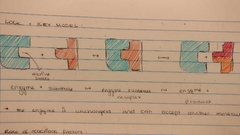
|
|
|
Digestion rate of of reaction factors (6) |
Temp pH Substrate conc Enzymes conc Surface area Pressure |
|
|
Temperature |
Higher = faster till optimum More kinetic energy, more collisions and work faater |
|
|
If pH changes from optimum... |
Enzymes become denatured and active site changes (irreversible) |
|
|
Denatured enzyme |
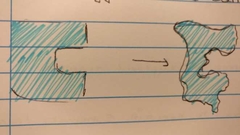
|
|
|
Substrate conc |
More substrate the slower the reaction |
|
|
Enzyme conc |
More enzymes the faster the reaction |
|
|
Surface area |
B;gger the area the faster the reaction |
|
|
Pressure |
Increase pressure and reaction speeds up |
|
|
Example of Enzymes (3) |
Protease Amalyse Lipase |
|
|
Protease |
Typsin + Pepsin Break proteins down into individual amino acids |
|
|
Typsin optimum pH |
pH 8-9 |
|
|
Pepsin optimum pH |
ph2 |
|
|
Process of Protease |
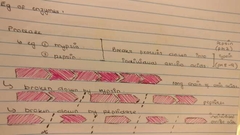
|
|
|
Amalyse |
Breaks carbohydrate molecules (starch) into glucose pH 7 |
|
|
Process of amalyse |
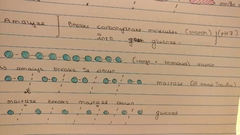
|
|
|
Lipase |
Breaks fats (lipids) into fatty acids and glycerol Alkaline oH |
|
|
Process of Lipase |

|
|
|
Bile |
Neutralises acid Lots of emulsion happens, breaks fat molecules down so they have a larger surface area to lipase can easily act on it |
|
|
Three tests |
Benedicts test Biuret Test Iodine Test |
|
|
Benedicts Test |
Tests for glucose Blue --> Brick Red/Orange |
|
|
Biuret Test |
Copper Sulphate + Sodium Hydroxide Tests for protein Blue --> Lilac |
|
|
Iodine Test |
Tests for starch Brown/red orange --> black / blue black |
|
|
Emulsion |
Bile surrounds the fat molecules and breaks them down so there is a larger surface area |
|
|
Digestive System Diagram |
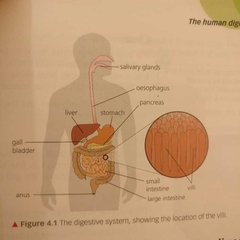
|
|
|
Enzyme |
A biological molecule that speeds up a chemical reaction |
|
|
Salivary Glands |
In your mouth Make saliva which acts as a lubricant making it easier to swallow food Contains amalyse |
|
|
Oesophagus |
Connects mouth to stomach (20cm) |
|
|
Stomach |
Between oesophagus and small intestine, it release protease
Hydrochloric acid (pH 2+3) so it is optimum for protease to work |
|
|
How long does it take food from stomach to small intestine |
6 - 8 hours |
|
|
Sphincter |
A ring of muscle that can open or close a tube |
|
|
Liver |
Large organ found in the right of the stomach, produces a green liquid called bile |
|
|
Gall Bladder |
Bile is stored here |
|
|
Pancreas |
Produces all three enzymes, pancreas release these into the top section of the small intestine (duodenum) |
|
|
Small Intestine |
Contains villi and peristalsis |
|
|
Villi |
In the lining of your small intestine Increase the surface area |
|
|
Peristalsis |
Rings of muscle around them, contract to squash lumps of food called boluses along your digestive system |
|
|
Large Intestine |
Absorbs water and salts from remaining digested food |
|
|
Anus |
Defecation |

